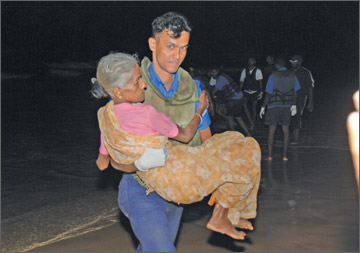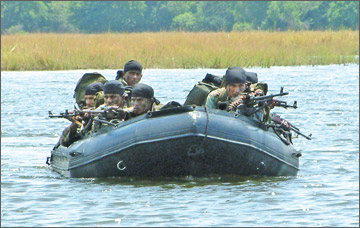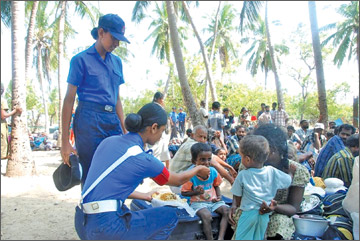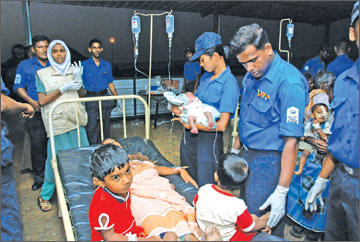Sri Lanka Navy: Riding a wave of success
By Ranil WIJAYAPALA

If we can remember the date August 1, 2006, four days after the
commencement of the Mavil Aru humanitarian operation, we can still
remember the way LTTE artillery guns installed at Sampur were directed
at the Trincomalee Naval Base while attempting to launch a suicide
attack on the 'Jet Liner', ferrying unarmed soldiers going on leave.
The prime target of the LTTE on the subsequent attack on Muttur,
Thoppur, and Kattaparichchan Army detachments immediately after midnight
of August 1, 2006 was to paralyse the activities of the Trincomalee
harbour which had become a major obstacle for their operations both in
the North and in the East.
 The LTTE was aware that it was only through crippling Navy activities
in Trincomalee that they could achieve any success in their terror
operations. That shows how LTTE considered the Sri Lanka Navy as a
threat to their terror operations connecting the North and the East.
That was why the LTTE whilst trying to open a land route connecting the
East and the North through the jungle terrain made desperate attempts to
get rid of the Navy presence in the Eastern seas to achieve the same
terror objective. The LTTE was aware that it was only through crippling Navy activities
in Trincomalee that they could achieve any success in their terror
operations. That shows how LTTE considered the Sri Lanka Navy as a
threat to their terror operations connecting the North and the East.
That was why the LTTE whilst trying to open a land route connecting the
East and the North through the jungle terrain made desperate attempts to
get rid of the Navy presence in the Eastern seas to achieve the same
terror objective.
Almost three years after the end of fighting both in the East and the
Wanni theatre, the ground troops came out with a exciting revelations
about the 'experiments' of the LTTE.
Many of their experiments were not merely for sea transportation but
also aimed at causing heavy damage to the Naval ships and boats that had
become a major obstacle for them.
The suicide boats laden with more than 2000 kgs of explosives found
in the coast of Chalai and Chundikulam very clearly prove that they had
major plans to disrupt the supplies between Trincomalee and
Kankesanthurai harbour which was the only lifeline to the Security
Forces and the civilians at that time.
But the Navy could accomplish its role by ferrying all the troops
going on leave and returning from leave in the Jaffna peninsula by the
'Jet Liner' and supplying what the entire Jaffna peninsula needed at
that time by sea.
The LTTE was very well aware that it was only through sea supplies
that they can keep their supplies intact.
So they were ready to do whatever possible to cause maximum damage to
the Navy. When they failed in their sea confrontations they tried their
best to harm the Navy personnel on land.
The suicide truck explosion in Digampotana in October 2006 bears
testimony on how the LTTE planned to kill sailors in desperate moves.
Therefore, when ground troops continued with their face to face
battles in the land the Navy had to operate in the sea with heightened
preparation to face unforeseen terror plans targeting their ships and
boats in mid sea.
 Facing all these suicide squadrons of the LTTE the Sri Lanka Navy was
brave enough to protect the Motherland by preventing almost all their
terror operations but with a lot of sacrifices and hard work to become
an equal partner in the victory against LTTE terror. Facing all these suicide squadrons of the LTTE the Sri Lanka Navy was
brave enough to protect the Motherland by preventing almost all their
terror operations but with a lot of sacrifices and hard work to become
an equal partner in the victory against LTTE terror.
To achieve that objective the Sri Lanka Navy, made an innovative
approach to the emerging threat from the sea-going wing of the LTTE.
First the Navy had to face the LTTE suicide boats in the sea, which
they compared to an intelligent guided torpedo, but unlike a torpedo can
be re-launched and cannot be neutralised by any electronic counter
measures and is capable of delivering a lethal punch ensuring a decisive
outcome.
The Navy geared up to meet the challenge by increasing its fleet
units, acquiring more effective weapons and better technology, to fight
the enemy more effectively out at sea.
The Navy understood that it would require Fast Attack Craft (FAC)
which could achieve about 30 knots and carry medium calibre weapons to
counter the threat from Sea Tigers.
A few FACs were initially purchased from Israel to meet this
requirement in 1985 and at the latter stage of the humanitarian
operation the number was increased drastically to meet the requirements
and the FAC squadron was restructured to face the threat effectively.
The Special Boat Squadron (SBS) of the Sri Lanka Navy, established in
the mid 1990s with the attacks launched in the Jaffna Lagoon against
terrorists by the Navy, made a great contribution to the Naval
operations by fighting the enemy on land and at sea bravely and
destroying formidable enemy targets successfully.
The Navy could deal with asymmetrical warfare at sea with FACs and
combined deployment of SBS and the Rapid Action Boat Squadron (RABS).
The deployment of the SBS and RABS yielded excellent results minimizing
damage to the Navy.
 But confronting the Sea Tigers in the seas was not the only objective
of the Navy. But confronting the Sea Tigers in the seas was not the only objective
of the Navy.
They had to think of new strategies other than confronting Tiger
boats disguising as fishing trawlers transporting arms and ammunition.
The far-sighted strategy of the Navy to go after the floating
warehouses of the LTTE in the deep seas thousands of miles away from Sri
Lanka became one of the turning points in Sri Lanka's effort of
defeating LTTE terrorism.
The SLN with limited blue water capability began intercepting the
LTTE ships and their efforts paid dividends as they were able to destroy
seven such ships which were carrying a large stock of weapons, mortars,
artillery ammunition, and parts of light aircraft, diving equipment,
torpedoes, and speed boats, Electro Optic devices, under water vehicles,
night vision devices and explosives during 2007 alone.
Those ships which were not flying any flag and did not carry proper
International Maritime Organization (IMO) identification numbers were
engaged in international waters off the shores of Sri Lanka.
What is more important in Naval history in this regard is the Navy's
performance of a very difficult task with great dedication by not
waiting till arms smugglers came closer but going out to destroy those
rogue ships in the high seas using special strategies based on long-term
planning and careful analysis of information gathered over a period of
time utilizing the Navy's limited resources to the maximum.
With the destruction of these three vessels, the Navy prevented the
LTTE terrorists from receiving their military supplies which they
desperately needed.
 . Kyoi destroyed south of Dondra on 28th February 2007 . Kyoi destroyed south of Dondra on 28th February 2007
. Seiyoo destroyed south east of Arugambay on 18th March 2007
. Destroyed south east of Arugambay on 18th March 2007
. Manyoshi destroyed south east of Dondra on 10th September 2007
. Seishin destroyed south east of Dondra on 10th September 2007
. Koshia destroyed south east of Dondra on 11th September 2007
. Matsushima destroyed south of Dondra on 07th October 2007
The sailors and the officers who fulfilled this task on behalf of
their Motherland were given due recognition by the President and the
Commander-in-Chief of the Security Forces Mahinda Rajapaksa at the
Eastern Naval headquarters in Trincomalee.
But achieving that objective alone was not enough in the long felt
objective of eliminating LTTE terrorism fully. The Navy had to be on
constant vigilance in the sea surrounding the island to ensure that LTTE
received no arms and ammunition and also to see that no Tiger cadre
escaped from the battlefront.
To achieve this objective effectively the Sri Lankan Navy in the
period from 2005 to 2010 deployed network centric sensors such as
surveillance radars, electro optic surveillance systems, automatic
identification system (AIS), high frequency surface wave radar (HFSWR)
and marine small target trackers around the Island to carry out
effective maritime surveillance.
The Navy's commitment was not only for the humanitarian operation. It
had to ensure that all the commercial activities based in harbours were
taking place as usual without disrupting the economic activities in the
country. Therefore it played a crucial role in securing the harbours,
especially the Colombo port and the Trincomalee Harbour.
With all these commitments protecting territorial waters of the
country going beyond its traditional roles, the Navy undertook security
on land as well when the Army needed to expand their presence in the
land.
A large area in the Trincomalee District was protected by the Navy.
Similar large areas in the Wanni and from Vavuniya to Mannar were made
secure through the deployment of Naval troops.
As the final phase of the battle shifted to the north of Mullaitivu
the pressure on the Navy was at its height as there were speculations
that Tiger leader Prabhakaran would flee by sea since the only means
available for him to escape was by sea.
Preventing such an escape was the biggest challenge and the Navy made
it an impossible task for the LTTE by successfully deploying a
well-fortified Naval barricade utilizing its vessels and craft with all
Naval personnel working with dedication and the commitment.
With all these commitments in the sea, the sailors and officers
engaged in humanitarian work when on civilians started escaping Tiger
grip starting from the early part of January.
The Navy helped the ICRC to evacuate civilian casualties caused by
the LTTE ship and also helped the civilians fleeing from boats to reach
safer destinations.
Today, almost two years after the defeat of LTTE terrorism the Sri
Lanka Navy continues its role of defending its territorial waters with
the same commitment as alerted by the presence of the LTTE's
international network as well as its remnants in Sri Lanka and their
collaborators' attempts to revive their sinister campaigns. Therefore,
the Navy is expanding its role along with the new challenges faced by
the island nation in the post conflict scenario. |

